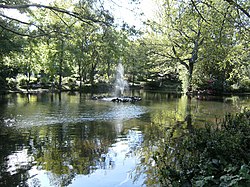
The Park Estate is a private residential housing estate to the west of Nottingham city centre, England. It is noted for its Victorian architecture, although many of the houses have been altered, extended or converted into flats. The estate uses gas street lighting, which is believed to be one of the largest networks in Europe.
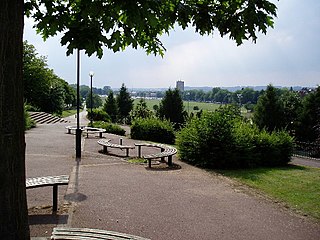
The Forest Recreation Ground is an open space and recreation ground in Nottingham, England, approximately one mile north of the city centre. This urban space is bounded by the neighbourhoods of Forest Fields to the north, Mapperley Park to the east, Arboretum to the south and Hyson Green to the west. It is best known as the site of the city's famous annual Goose Fair.

Birkenhead Park is a major public park located in the centre of Birkenhead, Merseyside, England. It was designed by Joseph Paxton and opened on 5 April 1847.

Derby Arboretum is a public park and arboretum in the city of Derby, England, located about 1 mile (1.6 km) south of the city centre in the Rose Hill area. It was opened in 1840, following the donation of the land by local philanthropist Joseph Strutt, and to designs by John Claudius Loudon. It was the first publicly owned, landscaped, urban, recreational park in England. After many years of neglect, the Arboretum was extensively refurbished in the early 21st century with the aid of a Heritage Lottery Fund grant of almost £5 million. It is listed as Grade II* on the Historic England Register of Parks and Gardens of Special Historic Interest in England.
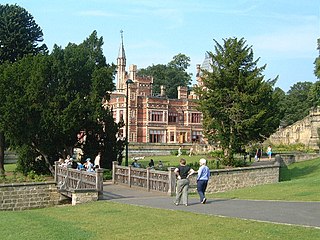
Saltwell Park is a Victorian park in Gateshead, Tyne and Wear, England. Opened in 1876, the park was designed by Edward Kemp and incorporates the mansion and associated grounds of the Saltwellgate estate owner, William Wailes, who sold his estate to Gateshead Council for £35,000. Upon opening, it became known as "The People's Park". The park was expanded in 1920 when the council purchased the adjacent gardens to the Saltwell Grove estate and added these to the park. This extended the park's total size to 55 acres (22 ha). Towards the end of the 20th century, the park had fallen into disrepair, but between 1999 and 2005, it was subject to a £9.6 million restoration project, funded collaboratively by the Heritage Lottery Fund and Gateshead Council and is now host to around 2 million visitors per year.

Leazes Park is a Grade II listed park urban park in Newcastle upon Tyne, England. It is the city's oldest park, opened in 1873, and lies to the west of the city centre. The park contains a lake above the course of the Lort Burn. It is next to St James' Park and the Royal Victoria Infirmary.

Dodington Park is a country house and estate in Dodington, South Gloucestershire, England. The house was built by James Wyatt for Christopher Bethell Codrington. The family had made their fortune from sugar plantations in the Caribbean and were significant owners of slaves. It remained in the Codrington family until 1980; it is now owned by the British businessman James Dyson.

The Lincoln Arboretum is an 22 acres (8.8 ha) park in Lincoln, Lincolnshire, England. The park has two ponds and varied tree cover, and was designed and laid out between 1870 and 1872 by the celebrated Victorian gardener Edward Milner. The arboretum is a park of Grade II importance.
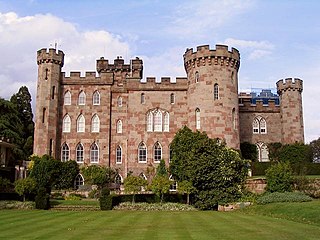
Cholmondeley Castle is a country house in the civil parish of Cholmondeley, Cheshire, England. Together with its adjacent formal gardens, it is surrounded by parkland. The site of the house has been a seat of the Cholmondeley family since the 12th century. The present house replaced a timber-framed hall nearby. It was built at the start of the 19th century for George Cholmondeley, 1st Marquess of Cholmondeley, who designed most of it himself in the form of a crenellated castle. After the death of the Marquess, the house was extended to designs by Robert Smirke to produce the building in its present form. The house is designated by English Heritage as a Grade II* listed building.
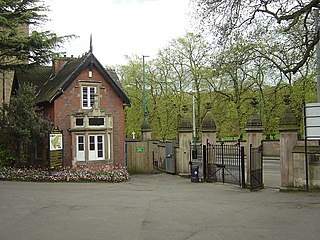
Henry Moses Wood was an architect based in Nottingham.

Mesnes Park ( is a Victorian public park dating from 1878 in Wigan, Greater Manchester, UK.

South Park is a historic park in Darlington, County Durham, England. It is Grade II listed with Historic England.

Nottingham General Cemetery is a place of burial in Nottingham, England which is Grade II listed.
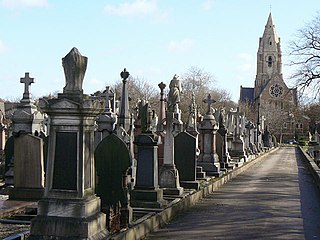
Church Cemetery, also known as Rock Cemetery, is a place of burial in Nottingham, England which is Grade II* listed. It is situated at the south-east corner of Forest Recreation Ground.

As of February 2001, there were 1,124 listed buildings with Grade II status in the English city of Brighton and Hove. The total at 2009 was similar. The city, on the English Channel coast approximately 52 miles (84 km) south of London, was formed as a unitary authority in 1997 by the merger of the neighbouring towns of Brighton and Hove. Queen Elizabeth II granted city status in 2000.
As of February 2001, there were 1,124 listed buildings with Grade II status in the English city of Brighton and Hove. The total at 2009 was similar. The city, on the English Channel coast approximately 52 miles (84 km) south of London, was formed as a unitary authority in 1997 by the merger of the neighbouring towns of Brighton and Hove. Queen Elizabeth II granted city status in 2000.
Kingstone is a ward in the metropolitan borough of Barnsley, South Yorkshire, England. The ward contains eight listed buildings that are recorded in the National Heritage List for England. Of these, one is listed at Grade II*, the middle of the three grades, and the others are at Grade II, the lowest grade. The ward is to the southwest of the centre of Barnsley, and is residential. It contains Locke Park, with three listed buildings, a statue, a tower and a bandstand. The other listed buildings are a church, a former stable block, a former public swimming baths, a guest house, and the churchyard walls and railings of a demolished church.
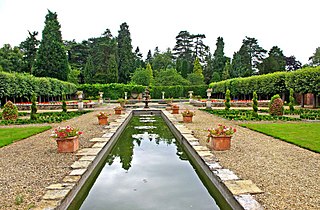
Arley House and Gardens are situated at Upper Arley, about 4 miles (6.4 km) north-west of Bewdley, in Worcestershire, England. The gardens, arboretum and parkland are listed Grade II in Historic England's Register of Parks and Gardens.

Nottingham Road Cemetery is a municipal cemetery in Chaddesden, an inner suburb of Derby, in central England. It was established in 1855 to provide more more burial capacity for the rapidly growing town.
Hyson Green and Arboretum is an electoral ward in the city of Nottingham, England. The ward contains over 60 listed buildings that are recorded in the National Heritage List for England. Of these, two are listed at Grade II*, the middle of the three grades, and the others are at Grade II, the lowest grade. The ward is to the north of the centre of the city, and includes the areas of Hyson Green and Arboretum. In the ward are buildings forming part of Nottingham Trent University, some of which are listed. The ward contains the open areas of Nottingham General Cemetery, the Forest Recreation Ground, The Arboretum and Church Cemetery, all of which contain listed buildings. In the past, the area was involved with the lace making industry, and in the ward are former workshops and factories that have been converted for other uses and are listed. The other listed buildings include houses, offices, shops, warehouses, war memorials, churches and associated structures, Nottingham High School, and a theatre.
